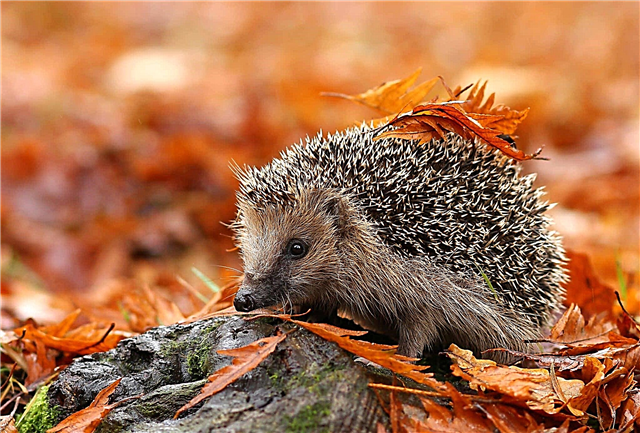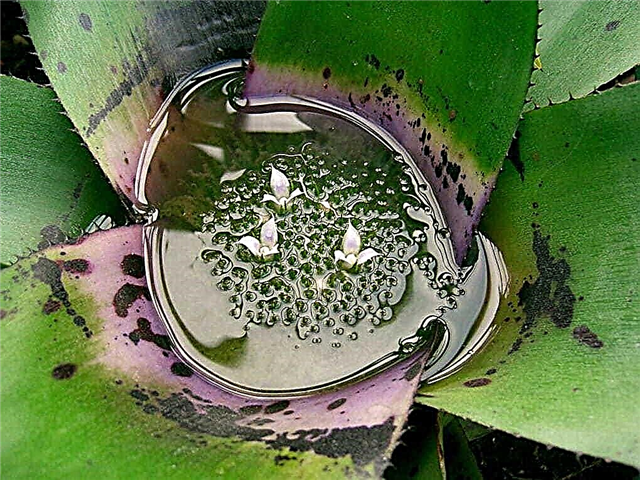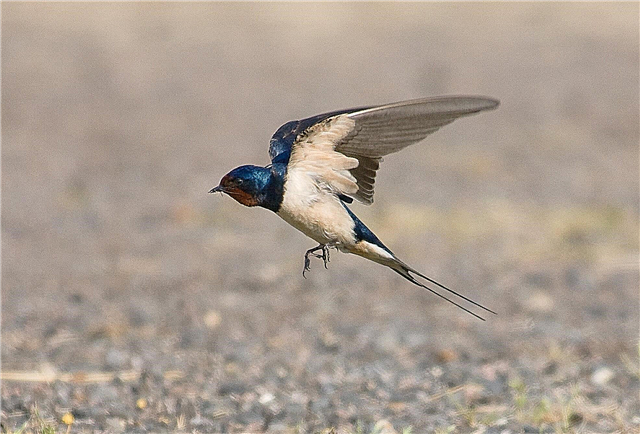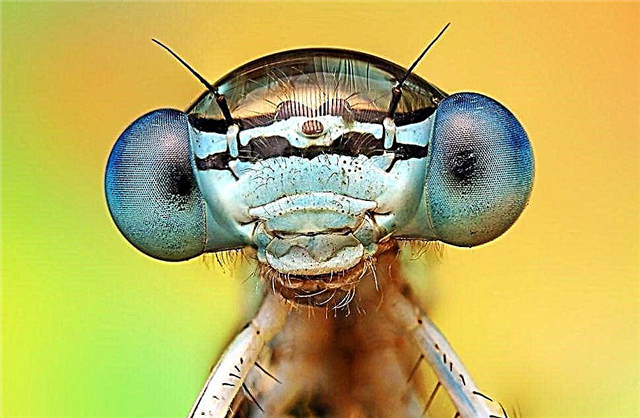
The construction technique, the final form and the main characteristics of bird buildings - primarily their strength and heat capacity - are determined by the properties of the nesting material.
Thick, unbending branches of trees and shrubs, the birds simply pile up, trying to fit them as tightly as possible to one another. In this way, large birds of prey and storks arrange their massive platform nests on the trees, achieving truly outstanding results.
Perennial nests
Once built, a well-visible nest from all sides becomes a landmark for many years. Different individuals will occupy it for several decades, which, due to natural industriousness, will also contribute to the accumulation of nesting material. The thickness of the platform will grow from year to year, the platform will turn into an impressive tower.
The famous bald eagle nest near Vermilion in Ohio (USA) was 2.5 meters across and over 3 meters high with a weight of about 2 tons. Probably, this is the most massive construction of birds of those that without any stretch can be called a typical nest, designed to breed offspring as a married couple. Only a few are inferior to this colossal structure nests of Pacific Steller's sea eagles in Kamchatka. The black neck of the neck in size resembles a wheel from the heaviest dump truck, reaching a two-meter diameter and almost a meter thick. In its walls, taking advantage of the peacefulness of the hosts, entire bird families are placed that tolerate each other quite tolerably.
Materials for the construction of nests
Many birds resort to the same simple layering technique. Around waterbirds, material is not branches, but various fragments of aquatic plants. The material is laid in a wet state, which, when dried, gives the building additional strength due to the “bonding” effect of the drying fragments.
In small birds with miniature nests, cobwebs are among the favorite materials, and they spend a lot of time searching for it. Being sticky and durable, it acts as a cementing material, fastening the individual layers of dry grass, and perfectly ensures the fastening of nests to the branches of a tree.
Tropical Nectarian Nests

The nests of tropical nectaries in their design are very peculiar and easily recognizable. In most species, the building looks like a very elongated pear hanging on the tip of a thin branch or suspended from the underside of a palm or banana leaf. In the lower expanded part of the "pear", a closed nesting chamber is arranged with a narrow side entrance, usually covered with a small peak on top. The construction is very tiny, and even the baby nectarina does not fit completely inside, so that the head of a hen with a long curved beak is almost always visible from the outside. The main building material is plant fluff, fastened with a large number of cobwebs, which is also used to hang nests.
Due to the large number of cobwebs flickering in the sunshine, the nests of some species look very elegant and resemble Christmas toys, which, by mistake, ended up on a palm tree. In general, the love of nectaries for the web is all-consuming in nature - the Russian name spider eaters, applied to some representatives of this group of birds, should be changed to spider lovers. Some nectaries do not build nests at all. Having found a good stratification of the web in a secluded corner in the crown of the tree, they lightly rake it in one place and lay eggs in the formed tray.
Reed nests

Worth mentioning are the nests of reeds, skillfully mounted on vertical stems standing next to each other.The stems pass through the side walls of the nest, which is held on the supports mainly due to friction or is “glued” with putty made of silt and mud. The shape of the reed nest resembles a cylinder or a ball with a truncated top, neatly twisted from blade of grass and reed leaves. The edges of the tray are always tightly tightened, sometimes the inside is “plastered” with the same mud, which, when dried, forms a smooth surface. Sometimes reeds attach a nest to live, growing stalks of nettles, meadowsweet or ivan tea, and in the month that has passed from the moment the building was laid to the departure of the chicks, it sometimes rises almost half a meter. The nest is attached to the reed stalks by the side walls.
“Pottery masters” - clay nests
Raw clay soil is also listed in the catalog of feathered building materials. The main bet on it was made by swallows, rocky nuthatch, magpie larks and some representatives of the family with the eloquent name of the stove-bird. Stucco nests are among the most skilled feathered constructions and resemble pottery. They are molded from small lumps of clay and therefore almost always have a characteristic small-tuberous surface, so that by the number of tubercles you can pretty accurately calculate how many servings of material were laid during the construction process.
Magpie Larks

Magpie larks are small, motley colored birds that live in the arid regions of Australia. Contrary to the name, from an evolutionary point of view, they tend more to raven birds and in fact resemble forty and half-trimmed tails. They are quite satisfied with the simplest cup-shaped nests open from above, mounted on tree branches and typical of most ravens. The only difference is that the nests of larks are entirely molded of clay. This gives only one advantage - the ability to build on thin horizontal branches, “sticking” the building to them, while for nests of a “standard” material that does not have the properties of cement, it is necessary to look for a fork in the branches or strengthen them near the trunk, along which a marsupial marten or a snake can climb.
Rocky Nuthatch Nests
The nest of a large rocky nuthatch looks like a narrow-necked jug glued bottom to the rock. The neck of the jug, that is, the entrance to the nest, is directed down and to the side. Such a “jug” usually weighs about 4-5 kilograms, but there are more massive buildings. The wall thickness reaches 7 centimeters, and the strength is such that it is impossible to break the nest with your hands. As a cementing mortar, nuthatches use the mucus of crushed caterpillars, beetles and butterflies, relentlessly smearing them on the surface of the nest, which over time here and there is covered with a colorful pattern from the wings of unfortunate victims.
Swallow nests

Modeled nests of swallows are distinguished by a wide variety of shapes. The simplest look is the building of village swallows open from above - exactly the half neatly cut along the cup, glued along a slice to the wall, certainly under the cover of some peak - a cornice or a rocky ledge. City swallows sculpt a nest closed on all sides with a narrow side entrance. Most often, a building in shape approaches a quarter of a ball attached from above and behind to two mutually perpendicular planes - usually to a wall and a roof visor.
The nest of the red lumbar swallow is distinguished by its extreme grace. It represents a half cut along a jug with a rather long neck and attaches directly to the ceiling.
Stove-bird nests

In the art of clay handling, the stove-bird inhabiting the Argentinean pampas has no competitors. In size and shape, its construction resembles a soccer ball attached to a strong tree branch or top of a pillar.In appearance, it looks straightforward, but arouses respect for its solidity, reaching a weight of 10 kilograms.
The side entrance leads to a rather spacious interior - a kind of lobby, to which the nest chamber itself is attached - a deep pocket molded from clay, somewhat similar to the nest of a village swallow. Squeezing into this “pocket” is not easy, because between the ceiling of the lobby and the upper edge of the “pocket” the stove-keepers leave a very narrow gap, so you can not be afraid of uninvited guests.
Why do birds build nests from clay?
Clay is malleable during construction and gives high strength to finished buildings. Why did these virtues turn out to be in demand by the “building industry” of birds on such a limited scale? The widespread use of clay for the construction of bird nests is hindered by its endless moods, depending on the weather. It’s too hot for her, and she dries up, often forcing him to suspend construction work that has already begun. That, on the contrary, is too damp, and the newly laid clay layers refuse to dry and harden, which also entails an unplanned pause in construction.
In addition, clay nests are desirable to build in the shade. Once in the sun, they can dry out and collapse, and chicks in a red-hot clay "stove" sit unsweetened. Therefore, swallows love to sit under the roofs of buildings, nuthatchers avoid building nests on the rocks of the southern exposure and almost always hide them under overhanging rock cornices, and stove-makers tend to lay their eggs as early as possible in the spring, until the sun has gained full strength.
Finally, clay nests are very laborious. To build your very small nest in perfect weather and full supply of materials, a couple of city swallows need to deliver from 700 to 1500 servings of clay (excluding dropped), which takes at least ten days. Stove ovens and nuthatch creepers with their massive nests require at least 2,000 lumps, and construction, accompanied by inevitable downtime, stretches for several weeks. Stove stoves do not hide nests from the sun and therefore are forced to increase their mass with all their might in order to reduce their heating rate and reduce the range of temperature fluctuations.
But with all the shortcomings, the molded nests nevertheless opened up a whole new approach to the security problem. Swallows and nuthatchers have the opportunity to “glue” their houses on the steepest cliffs hanging over the rapids of mountain rivers or falling into bottomless abysses, under the ceiling of caves and grottoes among mysterious twilight and eternal dampness, in a word, in places where predators are unable to get . In addition, the nests, fashioned in the form of chambers closed on all sides with a narrow entrance, perfectly protect the offspring, and, if necessary, parents from rain and cold.
Using clay soil, you can reduce the size of the inlet into the hollow, as our ordinary nuthatch comes in. They settle mainly in the hollows of large speckled woodpeckers with a letch of about 50-60 millimeters in diameter, while 35 millimeters are quite enough to crawl. The nuthatch eliminates the difference by carefully coating the summer with clay, silt or dung.
This activity has a purely instinctive nature. Even if a nuthatch nests in a hollow with a small letch, he will still generously spread clay on the bark of the tree around the letok.
"Spit .. and build"
Swift Nests
The attitude of the haircuts to the device of their nests can be described as “not giving a damn”. The main building material during construction is its own saliva, which has the ability to instantly harden in the air.
Swift is the best flyer among all birds. He lives on the fly - hunts for insects, quenches thirst, plays a wedding, has a rest, sleeps and so on.
The most famous representative of the swift suborder, numbering 58 species, is the black swift - an inhabitant of urban attics and birdhouses. The shape of its nests largely depends on the configuration of the nesting room, the presence of alien nesting material in it. Basically, the nest looks quite ordinary and is a kind of cake with raised edges like a saucer.
In terms of structural features and construction costs, the Cayenne Swift, which lives in Central and South America, builds the most complex and time-consuming nest. The building is suspended from an overhanging rock ledge and looks very much like a thick icicle with a broken tip. By its design, the socket is a tube with an entrance from below. Clinging with sharp claws, the swift climbs onto the protrusion of the inner wall, where the egg lies. At the top of the tube there is another false entrance, which ends in a dead end. The length of the "icicles" exceeds 60 centimeters, which is four times the length of the builder. It is not surprising that the construction takes almost six months and requires patience and determination from the birds. Pouring plant fibers and feathers in the air and, of course, producing saliva in an amount sufficient for construction is not easy.
With the help of saliva, swifts are able to glue eggs in the place of incubation - this allows them to get by with the tiniest nests and incubate the clutch in the most incredible position.
Palm swift nest

The nest of a palm swift, widespread in the tropics of the Eastern Hemisphere, in shape and size resembles a tablespoon without a handle. This “spoon” adheres to the underside of the hanging palm leaf in an almost vertical position. Eggs, of course, also stick - without it, they immediately fall to the ground. The “newborn” chicks tightly clutch their sharp cradles in their hanging cradle and hang for several weeks as their parents were hanging in front of them.
A nest of palm swifts obscures a leaf of palm from tropical showers. Crested swifts rely only on themselves in protecting their nests from rain. Compared to their own size, they build the smallest nests among all birds.
But not from a good life, but in order that the nest could be completely closed from the rains with its own body.
Meanwhile, in the nesting places of these birds in a tropical climate, it rains daily, as scheduled - right after lunch, and are severe until extreme. The construction is a tiny shelf of several pieces of bark glued together, plant fibers and fluffs glued to the side of a tree branch. There is enough space for only one testicle: the incubating bird has to sit on a branch, because its shelf will not stand it. Therefore, the branch where the nest is attached should not be thicker than a finger - otherwise I’m not cutting my fingers to grab it. Sitting under a fierce tropical downpour, amid a raging thunderstorm, a crested swift deserves to become a symbol of the feathered parental dedication.
"Carpenters" and "diggers"
Woodpecker nests

What professions only birds have not mastered in pursuit of the maximum comfort and safety of their nests! Some even had to master the skills of carpenters and diggers. These skills in both of them are based on the skillful use of the same working tool - their own strong beak, which, depending on the circumstances, can be used as a chisel or instead of a shovel. Therefore, the profession of a carpenter and a digger in the world of birds rather closely connected with each other.
Most of the 200 species of woodpeckers distributed around the world are native forest inhabitants, and they have no equal in the art of handling trees.When the main forest “carpenter” - yellow - enters into excitement and takes up the matter seriously, chips up to fifteen centimeters long fly around the “construction site” with a fountain. Zhelna is the largest of our woodpeckers, almost the size of a crow, and therefore needs a spacious "apartment". The depth of its hollow reaches 40 centimeters, the inner diameter is 25 centimeters.
The “construction” is carried out in turn by both partners, and it rarely takes less than two weeks. Work is carried out at a height of not less than 3 meters from the ground, and some couples climb almost 15 meters. Therefore, in early spring, until the grass rose, the tree, chosen by the yellow one, gives out from afar a large white chips lying on a distance of 10-12 meters from the trunk. The hollow of this species - even long abandoned by the "builders", is easy to recognize by the shape of the notch - it is usually not round like other woodpeckers, but ellipsoid, and sometimes almost rectangular, elongated along the trunk.

Most woodpeckers hollow out a new “home” each year.transferring the old one to the “secondary market” and acting as true benefactors in relation to other birds that have a chronic need for hollows. The hollow of the large speckled woodpecker, the most numerous and widely known “carpenter” of the Russian forests, is inhabited mainly by small songbirds — flytraps, redstart, and tits. They are quite satisfied with a room with a diameter of 14-15 and a depth of 20-25 centimeters. But especially important and even indispensable for forest birds, activities are desirable whose voluminous hollows provide refuge for such large birds as owls, pigeons, mergansers and gogol.
In modern forests, old hollow patriarchal trees have almost disappeared, so it’s almost impossible to find suitable hollows for owls, owls, clintukhs and natural sized hollows. Unlike other woodpeckers, inclined to change their place of residence annually, she wants to maintain a long-term attachment to old hollows, which does not prevent her at all, however, in spring to engage in the construction of new ones - “in reserve”.
With all the dexterity, woodpeckers still rarely dare to hollow hollows in solid wood of a perfectly healthy tree from beginning to end. Therefore, almost all woodpeckers consider aspen, with its soft wood, subject to core rot, a favorite tree that goes under the hollow. It is possible that by tapping the trunk before the start of the "construction", the woodpecker decides by ear whether it is worth starting work on this particular tree or whether it is better to look for another one.
A dwarf woodpecker is well established - one of the smallest representatives of forest carpenters, who lives in the bamboo forests of the Himalayas and Indochina. The bamboo trunk is hollow inside and is divided into sections by partition-internodes. It is enough for the bird to hollow the wall of the trunk 10-20 centimeters above the internode - and it has at its disposal a completely ready nesting chamber.
A red-headed woodpecker living in the same region does not build a hollow at all, but leads chicks inside the massive and certainly inhabited nests of large tree ants, nicknamed "fiery" for their liveliness and willingness to immediately launch powerful jaws and a poisonous sting.
The building material for the ants is a peculiar and rather strong “cardboard”, made from wood fibers carefully chewed and mixed with saliva. Woodpeckers make a hole with a diameter of about 5 centimeters in the shell of an ant nest and lay their eggs right among the brood chambers of insects. The secret of ant loyalty, whose incredible aggressiveness is known to all the inhabitants of the jungle, has not yet been solved in relation to woodpeckers, especially since feathered lodgers are not modest in nature and regularly eat ant pupae, without even interrupting incubation.
Burrows of the Common Kingfisher

Kingfishers are great masters in digging holes.They dig with their beaks, and they dig the ground out of the tunnel with their paws, backing back to the entrance, so dexterously that clay and sand fountain out of the hole. Choosing a place more comfortable, many birds lay several holes at the same time, often at a decent distance from each other. In the morning, the kingfisher works on one cliff, after lunch flies to another, and in the evening, you see, already from the third clay pours.
Digging holes requires concentrated effort and is very labor intensive. But the couple of kingfishers work with great enthusiasm, and the spouses not only do not evade work, but strive to make the most significant contribution to the construction and look forward to their turn with great impatience.
A finished hole is a narrow tunnel from thirty centimeters to three meters long, which runs horizontally or with a slight slope. The entrance of the hole is always facing the river, and in its depth is a round nesting chamber the size of an apple. This is a nursery in which up to five chicks can freely develop.
Among the birds there are many species that do not bother themselves with carpentry or earthwork, but willingly lodge in finished hollows and burrows. Residents of each type present their requirements to the premises. For example, big tits occupy the darkest and deepest hollows and do not tolerate cracks in artificial nests. On the contrary, pied flycatchers, also committed to nesting in hollows, do not like the dark, which is why in the practice of attracting birds the peculiar effect of “nesting aging” became known. Its essence is that the flycatchers most readily occupy the recently hung nest boxes with light walls from the inside, but almost do not populate the nesting sites, which have sagged for many years, whose walls have turned dark gray from time to time. But it’s enough to whitewash these nests inside, they again become attractive.
Achievements of the “weaving workshop”
The most amazing exhibits in the Museum of Bird Architecture are supplied by the “weaving workshop”. Outstanding craftsmen work here, who are so directly called weavers, almost all of them are smaller than a sparrow in size. “Workshop personnel” comprise more than 100 varieties of weavers; almost all of them live in the savannahs and forests of Africa. A small branch of the "workshop" is located in Southeast Asia - only 7 species work here. The entire “weaving workshop”, which is part of the weaver’s family, is divided into several subfamily departments, which differ greatly in the number of “personnel” and the features of the technological process.
Only 7 species are classified as passerines. They did not manage to fully master the weaving business, but this did not prevent one of them, though by collective efforts, from making an exhibit, which in the construction industry of the birds has every reason to be considered the most complex and one of the most bulky structures.
Construction Technique
All weaving nests are a variation on one theme. This is a spherical or ellipsoid chamber closed on all sides with a narrow entrance from below or from the side. In many species, a more or less long inlet tube leads to the nest, which makes the whole building resemble a bulb or retort. The weaving technique is very interesting. Unlike other birds, they build not hanging, but hanging nests.
First weaves the base. Acting with its beak, paws, fluttering around the necessary branch, the bird manages to wrap it quite tightly with a small amount of building material. Then one of the neighboring branches is wrapped, and the birds connect them to each other with a pair of fabric jumpers from below and above. A semblance of a ring forms, which eventually turns into a basket and then into a flask, in a word, into a finished dwelling.
Only males are engaged in the construction of weavers, and many of them do not bother to visit the nests themselves constructed at least once. The fact is that, without exception, all the construction work they have decided to do outside without climbing inside the room.Arriving with the next strip, the male invariably occupies the same working position - on the lower bridge of the ring, with its beak to the future far wall of the nest and its back to its future entrance. Thus, the weaver leads the construction in the direction of "himself" and as the size of the building increases, under its "onslaught", he is forced to lean more and more backward, with astonishing tenacity holding his paws to their original place. To finish the construction and invite the bride to inspect the apartment, he has to turn upside down, that is, hanging his back down and holding his claws behind the threshold of the house.
Collective Creativity Results
Public Weaver Nest

We will now move from East Africa, in the savannas of which most of the varieties of real weavers live, to the Namib desert, which stretches in a narrow strip along the coasts of the Atlantic in the south-west of the African continent, washed by the cold Benguelan current. The local regions are characterized by severe climate and are not rich in birds.
But which ornithologist will refuse the opportunity to visit this inhospitable land, under the grim name Skeleton Coast? Indeed, it is here that one of the main wonders of the feathered construction industry can be seen - the collective nest of public weavers.
The result of collective creativity is noticeable from afar and resembles a large haystack, swept away at someone’s whim not on the ground, but in the crown of a tree. Especially often, such “mounds” are found on wood lilies-cockers with their extremely thick succulent (succulent) trunk, which serves as a reservoir of moisture, and a round head of short and clumsy branches. "Kopna" is mounted on the thickest branches and is a cone-shaped densely pressed mass of dry grass, covered on top with a thick and durable layer of densely laid prickly twigs and coarse plant stems forming a kind of roof.

Residential nesting chambers are located in the lowest layer of soft material. Their entrances are facing down and located not far from each other, so that when viewed from below, the picture is somewhat reminiscent of a honeycomb. Upstairs from residential nests on several floors are old nests, long abandoned by the owners and completely filled with nesting material.
The maximum height (or thickness) of collective nests reaches one meter, the circumference is 3-4 meters. Dozens of generations of weavers are engaged in the construction of these grandiose buildings that live to a century of age; in large nests, up to 500 individuals coexist at the same time. Having served its purpose, the “shock” breaks the support and falls to the ground.
The delivery and packing of the material the population of the colony is concerned year-round. In winter, weavers have little interest in the lower surface and mostly spend time on the roof, where rough dried stems of weeds and dry and prickly acacia branches drag with great diligence. Everyone is flattered to place their offering above the others, which is why the roof inevitably takes the form of a rather regular conical dome.
With the advent of spring, the attention of birds is increasingly shifting to the “soft abdomen” of the building, that is, to its lower surface. Having found a place here and hanging its backs down on its paws, the weaver takes it with his beak to carefully and methodically stick the ends of the grass sticking outward into the thickness of the material. This work, of course, requires patience. In the end, a pit forms on the lower surface of the soft layer, which, using the same painstaking technique, deepens and expands until it reaches the volume of the nesting chamber.
At the same time, at some point, the builder begins to bring additional blades of grass to the “construction site” and, acting in the usual way, inserts them into the material around the pit. Thus, the layer of material grows even more, and the nesting chamber immerses itself faster and faster into its thickness.Thus, the nesting construction of the colony of public weavers increases throughout the year, but in winter it grows upwards, while with the beginning of the nesting season it grows down.
The most amazing nest is built by an African remez: being generally similar to a nest of an ordinary remez, it has two entrances. Outside, a false dead-end entrance is clearly visible, as for the entrance to the nest's premises, it is often not easy to see it, because it is covered by a soft entrance tube, which is not too easy to penetrate even for hosts.
Construction work on remezs is exclusively done by males. A single male lays the foundation of the building and attracts the female by singing. If it is not there for a long time, the male erects a new building nearby and sings near it. The technology of construction is peculiar. Arriving at the construction site with a bundle of soft plant fibers in its beak, the male reinforces them with one end on the support branch and starts to spin around it quickly, catching it with its paws and winding the fibers around the base like a thread on a spool. In an hour, the “builder" brings nesting material 10-15 times. After 3-4 hours of work, the male connects the twisted branches to each other with a cross from a bunch of grass, so that the base of the nest is formed in the shape of a triangle or ring. Now the male begins to wear not only elastic plant fibers, which go to strengthen the foundation of the structure, but also large bundles of fluff that stick into different places between the fibers and gradually form the walls of the nest.
Already at the end of the first day of construction, the nest takes the form of a miniature and neat little basket with a handle - thicker and wider at the base. Subsequently, the lateral edges of the basket become higher, the holes decrease and finally the roof arch closes. Now it remains only to attach the entrance lobby in the form of a tube, and the nest is ready. We note that the exact same sequence of actions, even down to the coincidence in the smallest details, is also characteristic of the weavers already mentioned, who also build hanging sockets, but use other materials and other technology for their fastening.
During the construction, males are forced to vigilantly guard the territory around their nests, because if the building is oversaw, especially unfinished ones can be destroyed by other males who consider the alien (as well as last year's abandoned) nests only as a warehouse of nesting material.
The family life of cuts looks rather bizarre, mating unions in these birds are usually very ephemeral. After the pair is formed, the male remeza quickly completes the construction (sometimes with the participation of the female) and in the future it can devote itself to incubation of masonry, or it can fly on a journey and in the same summer get a new family at a distance of 25-30 kilometers from the old one.
The construction instinct overwhelms many males so much that they often try with all their might to finish a ready-made nest with masonry, while causing displeasure and even direct aggression on the part of females, which show well-founded fears for the preservation of eggs. In turn, some females have time to put up to three clutches in the nests of different males over the summer. Some females leave masonry in the care of males, some remain incubated - alone or with the help of spouses. Many clutches die because parents quarrel all the time, cannot “agree” on which of them will be a hen.












